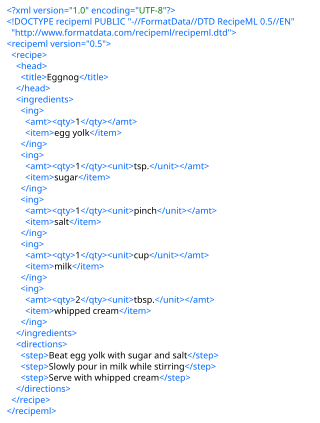Related Research Articles

LaTeX is a software system for typesetting documents. LaTeX markup describes the content and layout of the document, as opposed to the formatted text found in WYSIWYG word processors like Google Docs, LibreOffice Writer and Microsoft Word. The writer uses markup tagging conventions to define the general structure of a document, to stylise text throughout a document, and to add citations and cross-references. A TeX distribution such as TeX Live or MiKTeX is used to produce an output file suitable for printing or digital distribution.

A markuplanguage is a text-encoding system which specifies the structure and formatting of a document and potentially the relationships among its parts. Markup can control the display of a document or enrich its content to facilitate automated processing.

The Standard Generalized Markup Language is a standard for defining generalized markup languages for documents. ISO 8879 Annex A.1 states that generalized markup is "based on two postulates":

Extensible Markup Language (XML) is a markup language and file format for storing, transmitting, and reconstructing arbitrary data. It defines a set of rules for encoding documents in a format that is both human-readable and machine-readable. The World Wide Web Consortium's XML 1.0 Specification of 1998 and several other related specifications—all of them free open standards—define XML.
Mathematical Markup Language (MathML) is a mathematical markup language, an application of XML for describing mathematical notations and capturing both its structure and content, and is one of a number of mathematical markup languages. Its aim is to natively integrate mathematical formulae into World Wide Web pages and other documents. It is part of HTML5 and standardised by ISO/IEC since 2015.
In computing, RELAX NG is a schema language for XML—a RELAX NG schema specifies a pattern for the structure and content of an XML document. A RELAX NG schema is itself an XML document but RELAX NG also offers a popular compact, non-XML syntax. Compared to other XML schema languages RELAX NG is considered relatively simple.
A document file format is a text or binary file format for storing documents on a storage media, especially for use by computers. There currently exist a multitude of incompatible document file formats.
A lightweight markup language (LML), also termed a simple or humane markup language, is a markup language with simple, unobtrusive syntax. It is designed to be easy to write using any generic text editor and easy to read in its raw form. Lightweight markup languages are used in applications where it may be necessary to read the raw document as well as the final rendered output.
The following tables compare general and technical information for a number of document markup languages. Please see the individual markup languages' articles for further information.

Markdown is a lightweight markup language for creating formatted text using a plain-text editor. John Gruber created Markdown in 2004 as an easy-to-read markup language. Markdown is widely used for blogging and instant messaging, and also used elsewhere in online forums, collaborative software, documentation pages, and readme files.
Scrivener is a word-processing program and outliner designed for writers. Scrivener provides a management system for documents, notes and metadata. This allows the user to organize notes, concepts, research, and whole documents for easy access and reference. Scrivener offers templates for screenplays, fiction, and non-fiction manuscripts. After writing a text, the user may export it for final formatting to a standard word processor, screenwriting software, desktop publishing software, or TeX.
A mathematical markup language is a computer notation for representing mathematical formulae, based on mathematical notation. Specialized markup languages are necessary because computers normally deal with linear text and more limited character sets. A formally standardized syntax also allows a computer to interpret otherwise ambiguous content, for rendering or even evaluating. For computer-interpretable syntaxes, the most popular are TeX/LaTeX, MathML, OpenMath and OMDoc.
Extensible HyperText Markup Language (XHTML) is part of the family of XML markup languages which mirrors or extends versions of the widely used HyperText Markup Language (HTML), the language in which Web pages are formulated.
Doxia is a content generation framework that provides its users with powerful techniques for generating static and dynamic content. Doxia can be used in web-based publishing context to generate static sites, in addition to being incorporated into dynamic content generation systems like blogs, wikis and content management systems. Doxia is now a subproject of Apache Maven which uses it to convert APT markup documentation into HTML or other formats.

Org Mode is a mode for document editing, formatting, and organizing within the free software text editor GNU Emacs and its derivatives, designed for notes, planning, and authoring. The name is used to encompass plain text files that include simple marks to indicate levels of a hierarchy, and an editor with functions that can read the markup and manipulate hierarchy elements.
Setext is a lightweight markup language used to format plain text documents such as e-newsletters, Usenet postings, and e-mails. In contrast to some other markup languages, the markup is easily readable without any parsing or special software.
Pandoc is a free-software document converter, widely used as a writing tool and as a basis for publishing workflows. It was created by John MacFarlane, a philosophy professor at the University of California, Berkeley.
References
- ↑ "Ideas for MultiMarkdown". fletcherpenney.net. Archived from the original on 2007-05-09.
- ↑ Penney, Fletcher T. (2022-06-26), fletcher/MultiMarkdown-6 , retrieved 2022-06-30
- ↑ Penney, Fletcher T. (2022-06-26). "MultiMarkdown 6 Development Notes" . Retrieved 2022-06-30.
- ↑ Leonard, Sean (March 2016). "Guidance on Markdown: Design Philosophies, Stability Strategies, and Select Registrations". Request for Comments: 7764. Internet Engineering Task Force. Retrieved 27 March 2022.
This document elaborates upon the text/markdown media type for use with Markdown, a family of plain-text formatting syntaxes that optionally can be converted to formal markup languages such as HTML. Background information, local storage strategies, and additional syntax registrations are supplied.
- ↑ "MultiMarkdown Features". fletcherpenney.net. Retrieved 2022-06-30.
- ↑ "MultiMarkdown". fletcherpenney.net. Retrieved 2022-06-30.
- ↑ "Human Markdown Reference" . Retrieved 2022-06-30.
- ↑ "MultiMarkdown v6 Syntax Guide". rawgit.com. Retrieved 2022-06-30.
- ↑ Sparks, David (2011-09-26). iPad at Work. John Wiley & Sons. p. 176. ISBN 978-1-118-20568-6.
- ↑ Buffalo, Vince (2015-07-01). Bioinformatics Data Skills: Reproducible and Robust Research with Open Source Tools. "O'Reilly Media, Inc.". ISBN 978-1-4493-6750-3.
- ↑ "MultiMarkdown features". fletcherpenney.net. Retrieved 2022-06-30.
- ↑ Hernandez, Gwen (2012-07-30). Scrivener For Dummies. John Wiley & Sons. ISBN 978-1-118-31246-9.